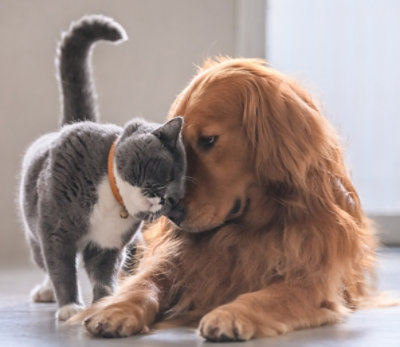Welcome back!
You're currently shopping with your default address:
National Pet Day is April 11. But don’t forget to celebrate National Dog Day on August 26 and National Cat Day on October 29.
Cats typically use the litter box a few times each day. When training a cat to use the litter box, make sure it is low to the ground, accessible and cleaned regularly. When switching to a new type of kitty litter, start by mixing with their current litter to transition gradually.
Dogs bond emotionally with their humans. Physical contact makes them feel closer and secure. Before engaging in petting, let the dog initiate contact. A dog will give cues if they want to be approached - ears back, relaxed posture, brief eye contact, untucked tail. You should always approach them from the side instead of above their head. The most common places dogs like to be pet are the chest, shoulders, base of the neck, and base of the tail. Petting should be done in a slow, repetitive motion, going with the direction of their fur.
Puppies should make the transition to adult dog food at twelve months of age. The transition should happen over 7 -10 days so their system can adjust to the change. Begin by feeding a mix of ¼ adult food and ¾ puppy food for the first few days. Then transition to ½ adult food and ½ puppy food for a few more days, followed by ¾ adult food and ¼ puppy food. Finally, the diet moving forward can be 100% adult dog food.
Typically, kittens should transition to adult cat food at around twelve months. Some larger breeds like Maine Coon and Ragdoll Cats take longer to reach maturity and may transition to cat food around 18 months. The transition should happen over 7 -10 days so their system can adjust to the change. Begin by feeding a mix of ¼ adult food and ¾ kitten food for the first few days. Then transition to ½ adult food and ½ kitten food for a few more days, followed by ¾ adult food and ¼ kitten food. Finally, the diet moving forward can be 100% adult cat food.
No one food fits all when it comes to feeding dogs. The packaging on a bag of dog food will have instructions on how much to feed; however, these recommendations are general and not specific to each dog’s individual needs. The amount of each nutrient and the amount of food a dog needs will depend on the following factors: age, size, weight, and health considerations. However, in general, puppies under three months of age should be fed at least four times a day. Puppies between 3 - 5 months old should be fed 3 meals a day, and adult dogs over 12 months should be fed twice a day. We recommend a good quality dog food that contains all the nutrients a dog needs; however, some dogs with specialized diets may need a supplement.
Yes! Brushing a dog’s teeth is one effective way to prevent dental diseases. Regular tooth brushing helps maintain good dog oral health and prevents oral health treatments and tooth extractions. Dogs will benefit from tooth brushing 2 - 3 times a week. However, daily brushing is recommended. Other at-home solutions to supplement dental care include dental chews, oral dental spray, nontoxic water bowl additives, and plaque wipes.
Yes! Brushing a cat’s teeth is one effective way to prevent dental diseases. Regular tooth brushing helps maintain good feline oral health and prevents oral health treatments and tooth extractions. Cats will benefit from tooth brushing 2 - 3 times a week. However, daily brushing is recommended. Other at-home solutions to supplement dental care include dental bites, oral dental spray, water bowl additives, and plaque wipes.
Some at-home solutions to maintain a dog’s skin and fur include:
Pet parents should always consult with a vet before usage.
Dogs need a balanced diet that includes six essential nutrients - water, protein, carbohydrates, fats, minerals, and vitamins. The most important nutrient is water, which makes up more than half of a dog’s body weight. Proteins and fats are necessary for bodily functions and healthy skin and hair growth. Carbohydrates are a good energy source, and vitamins and minerals support cell processes, digestion, and bone development.
